No products in the cart.
NEWS
Transform Your Balcony: Top Plants for Sun, Shade, and Air Purification
Adding lush greenery to your home, especially during warm summer days, can turn a simple balcony into a refreshing oasis. As an expert in horticulture, I understand the desire to connect with nature right within your living space. This article will guide you through selecting the best balcony plants, exploring their numerous benefits, providing essential care tips, and considering the unique conditions of your balcony’s orientation. Get ready to discover how easy and rewarding balcony gardening can be!
Why Grow Balcony Plants? The Benefits Unveiled
Cultivating plants on your balcony offers far more than just aesthetic appeal. It’s an investment in your well-being and the health of your home environment.
Creating a Green Oasis
Your balcony space, no matter how small, can be transformed into a miniature garden sanctuary. By selecting beautiful balcony plants that match your style and even align with principles like Feng Shui, you create a personal haven. Imagine stepping out to enjoy a morning coffee surrounded by vibrant blooms and calming green foliage. This touch of nature right at your doorstep significantly enhances the beauty and tranquility of your living space. When balcony plants are in bloom, they add spectacular bursts of color, further elevating the visual appeal. Adding comfortable seating allows you to fully immerse yourself in this relaxing atmosphere.
Improving Air Quality
Scientific studies consistently show that indoor and balcony plants play a vital role in removing common indoor pollutants and toxins such as formaldehyde and benzene. Effectively acting as natural air filters, they help purify the air you breathe daily. Certain varieties, like Snake Plants and Ivy, are particularly renowned for their air-purifying capabilities, actively working to cleanse the air around them. Furthermore, some plants naturally deter insects while releasing subtle, pleasant fragrances that contribute to a relaxing environment and uplift the human spirit.
Boosting Well-being & Health
Incorporating green life into your home environment contributes significantly to the health of its inhabitants. Simply gazing at your balcony plants daily can be a powerful stress reliever after demanding work or study periods. Additionally, the presence of plants can help increase indoor humidity, which may reduce allergens.
In our modern lives, we are constantly exposed to blue light from electronic devices. Growing plants on your balcony or indoors can help absorb some of the radiation emitted by these devices, potentially mitigating negative effects on your eyes, skin, and overall health. Research also indicates that phytoncides released into the air by plants can help strengthen the human immune system, further boosting overall health.
Enhancing Productivity & Focus
Engaging in the gentle routine of caring for your plants can foster a calming and sophisticated habit. This practice itself is relaxing, helping to lower heart rate and blood pressure. Spending time with your plants can alleviate mental fatigue and boost happiness. The calming green color of balcony plants is known to reduce nervous tension and eye strain, especially important for those spending hours in front of screens.
Moreover, being around plants has been shown to improve concentration and cognitive function. This can lead to enhanced memory retention and increased productivity. This is why many businesses, offices, and families actively incorporate plants into their spaces, including balconies, to reap these benefits.
Attracting Luck & Prosperity (Feng Shui)
In many Eastern traditions, plants hold significant Feng Shui meaning, used to decorate and enhance the flow of positive energy (Vượng Khí) in a home. While growing balcony plants, consider their placement carefully according to these principles. Choosing plants that are not only visually appealing but also considered auspicious can amplify their positive impact.
According to Feng Shui, certain plants can help neutralize negative energy (Xui Xẻo). A well-placed potted plant can act as a screen, blocking harmful chi. Positioning plants between certain points is also believed to help resolve potential misfortunes. Correct placement is thought to ward off negative influences, contributing to a space filled with positive energy and attracting wealth and good fortune.
Top Balcony Plants for Sun, Ease, and Air Purification
Choosing the right plants for your balcony depends largely on your climate, how much sunlight your balcony receives, and how much time you have for care. Here are some excellent options, often favored for their resilience and beauty:
Sun-Loving Stars
These plants thrive in direct sunlight and are perfect for bright, exposed balconies.
Kalanchoe: These plants are exceptionally drought-tolerant, making them ideal sun-loving balcony plants. Their fleshy stems and leaves store water efficiently, allowing them to endure hot conditions. Kalanchoes offer a spectacular array of brightly colored flowers, adding vibrant hues to your balcony space.
 Vibrant red and pink Kalanchoe flowers blooming in a pot, a drought-tolerant sun-loving balcony plant option
Vibrant red and pink Kalanchoe flowers blooming in a pot, a drought-tolerant sun-loving balcony plant optionBamboo Palm (Trúc Quân Tử): A hardy choice known for its strong root system and flexible stems, making it resistant to wind and rain. It grows quickly and is relatively pest-free. Besides providing shade, the Bamboo Palm is believed to bring a sense of peace and tranquility to the home. This is an easy-care balcony plant that tolerates sun.
 Lush green fronds of a Bamboo Palm plant suitable for balconies, symbolizing peace
Lush green fronds of a Bamboo Palm plant suitable for balconies, symbolizing peaceAloe Vera: A popular succulent that thrives in sunny conditions. It’s easy to grow and care for, requiring minimal watering as it stores water in its leaves. Aloe Vera is not only decorative but also offers medicinal benefits, known for its soothing properties for skin irritations and burns, and can be used in health drinks. A resilient sun-tolerant balcony plant.
 Spiky, fleshy leaves of an Aloe Vera plant in a pot, highlighting its drought tolerance and medicinal uses
Spiky, fleshy leaves of an Aloe Vera plant in a pot, highlighting its drought tolerance and medicinal usesJapanese Sago Palm (Vạn Tuế): This attractive plant enjoys bright light and high temperatures, thriving even in direct sun outdoors. Its lush, green fronds make it an excellent sun-blocking balcony plant, providing natural shade with its wide canopy. An easy-care option for sunny spots.
 A young Japanese Sago Palm with spreading green fronds, a sun-loving plant for balcony shade
A young Japanese Sago Palm with spreading green fronds, a sun-loving plant for balcony shadeCactus: Cacti are quintessential sun-lovers, perfectly adapted to hot, arid environments. Their fleshy bodies store water, and their spines vary by species. They grow well in sunny, hot conditions and require very little water, making them one of the easiest balcony plants to care for. Watering once a week or two is usually sufficient to prevent rot.
 Variety of small cacti growing in pots, hardy sun-tolerant plants for apartment balconies
Variety of small cacti growing in pots, hardy sun-tolerant plants for apartment balconiesPetunia (Dạ Yến Thảo): Petunias are popular flowering balcony plants that thrive in sunny locations. Easy to grow and care for, their abundant blooms add significant aesthetic appeal. They are often grown in hanging baskets or pots, creating a beautiful cascade of color over the balcony railing. Available in many colors like white, purple, pink, and red. A great sun-loving balcony plant for continuous blooms.
 Colorful Petunia flowers in various shades overflowing from hanging baskets on a balcony
Colorful Petunia flowers in various shades overflowing from hanging baskets on a balconyVinca (Dừa Cạn): If you need a sun-tolerant balcony plant, Vinca is an excellent suggestion. It handles sun and drought extremely well and blooms almost year-round, keeping your balcony vibrant and full of life.
 Bright pink and white Vinca flowers blooming profusely in a pot, a drought-tolerant balcony plant
Bright pink and white Vinca flowers blooming profusely in a pot, a drought-tolerant balcony plantPink Trumpet Vine (Hoa Hồng Anh): Originating from Brazil, this vine is easy to grow, healthy, and resistant to pests. It thrives in bright light, making it perfect for sunny balconies. Even in intense heat, it continues to grow normally, creating a pleasant, airy, and fresh atmosphere that promotes comfort.
 Close-up of pink trumpet-shaped flowers of the Pink Trumpet Vine trailing on a support
Close-up of pink trumpet-shaped flowers of the Pink Trumpet Vine trailing on a supportYellow Bell Vine (Hoa Hoàng Thảo): Another fast-growing climber with a strong grip and beautiful five-petaled yellow bell-shaped flowers. It blooms year-round, is easy to care for, prefers drier conditions, and is a sun-tolerant balcony plant.
 Bright yellow bell-shaped flowers of the Yellow Bell Vine climber
Bright yellow bell-shaped flowers of the Yellow Bell Vine climberGeranium (Hoa Phong Lữ): Known for its charming beauty, diverse colors, and resilience. Geraniums bloom in clusters with many vibrant and unique colors, making your balcony bright and lively. A classic choice for sunny balcony displays.
 Cluster of vibrant red Geranium flowers blooming in a pot, suitable for sunny balconies
Cluster of vibrant red Geranium flowers blooming in a pot, suitable for sunny balconiesBougainvillea (Hoa Giấy): A very common and popular balcony plant, especially known for its trailing habit, creating spectacular flowering displays. Bougainvillea also helps purify the air, removing toxins, particularly beneficial near busy streets where smoke and dust are prevalent. It contains natural anti-inflammatory compounds in its leaves, can help prevent diabetes, and inhibits bacterial attacks. Abundant blooms and wide growth are believed to bring luck and good fortune. Some believe this plant helps ward off negative spirits and bad luck. A robust sun-loving balcony plant that trails beautifully.
 Brilliant magenta Bougainvillea flowers creating a wall of color on a sunny balcony
Brilliant magenta Bougainvillea flowers creating a wall of color on a sunny balconyRangoon Creeper (Hoa Giun): Also known as Quisqualis indica, this vine has clusters of flowers in three main colors: red, pink, and white. The blooms grow in bunches of 15-20 flowers, with colors often intermingling. This sun-loving climber is perfect for beautifying your balcony and adding a gentle fragrance.
 Clusters of red, pink, and white Rangoon Creeper flowers on a vine, suitable for sunny balconies
Clusters of red, pink, and white Rangoon Creeper flowers on a vine, suitable for sunny balconiesRed Leaf Fig (Đa Búp Đỏ): A good sun-tolerant balcony plant that thrives even in hot weather. It grows quickly, is pest-resistant, and easy to care for, making it a reliable choice for sunny spots.
 Glossy, dark red leaves of a Red Leaf Fig plant, a sun-tolerant and easy-care balcony plant
Glossy, dark red leaves of a Red Leaf Fig plant, a sun-tolerant and easy-care balcony plantSucculents (Sen Đá): Including varieties like Stonecrop and Echeveria, these are drought-tolerant plants that grow quickly and thrive in sun. Their fleshy exteriors store water. They prefer bright light and need good drainage to prevent root rot. Care involves mindful watering to avoid oversaturation.
 Various types of small succulents with fleshy leaves arranged in a pot, drought-tolerant balcony plants
Various types of small succulents with fleshy leaves arranged in a pot, drought-tolerant balcony plantsLavender Scallops (Tuyết Sơn Phi Hồng): This unique plant catches the eye with its name and appearance. It features silvery-green leaves often edged with pink or purple, and delicate pinkish-purple flowers. Originating from arid regions, it is drought-tolerant and well-suited for growing outdoors on a balcony.
 Close-up of the distinctive variegated silvery-green leaves with pink edges of Lavender Scallops (Kalanchoe fedtschenkoi)
Close-up of the distinctive variegated silvery-green leaves with pink edges of Lavender Scallops (Kalanchoe fedtschenkoi)
Easy-Care Champions
These plants are forgiving and low-maintenance, perfect for busy individuals or beginner gardeners.
Bamboo Palm (Trúc Quân Tử): Mentioned above, its resilience to weather and fast, low-maintenance growth makes it an easy choice.
 Lush green fronds of a Bamboo Palm plant suitable for balconies, symbolizing peace
Lush green fronds of a Bamboo Palm plant suitable for balconies, symbolizing peaceAloe Vera: Its drought tolerance and minimal watering needs make it incredibly easy to keep alive.
 Spiky, fleshy leaves of an Aloe Vera plant in a pot, highlighting its drought tolerance and medicinal uses
Spiky, fleshy leaves of an Aloe Vera plant in a pot, highlighting its drought tolerance and medicinal usesSnake Plant (Lưỡi Hổ, Lưỡi Mèo): Known for its extreme resilience and ability to tolerate neglect, varying light conditions, and infrequent watering.
 Tall, upright, dark green leaves of a Snake Plant (Sansevieria) in a pot, known for air purification
Tall, upright, dark green leaves of a Snake Plant (Sansevieria) in a pot, known for air purificationZZ Plant (Kim Tiền): This plant features plump, glossy green leaves and grows from rhizomes. It prefers bright light but tolerates low light and is extremely drought-tolerant, requiring very little water. It’s very easy to grow, pest-resistant, and is also believed to bring wealth and fortune according to Feng Shui. An ideal sun-facing or bright indirect light balcony plant.
 Glossy, dark green leaves of a ZZ Plant (Zamioculcas zamiifolia), an easy-care indoor or balcony plant
Glossy, dark green leaves of a ZZ Plant (Zamioculcas zamiifolia), an easy-care indoor or balcony plantCactus: As discussed, their adaptation to harsh conditions makes them one of the easiest plants, requiring minimal water and thriving on neglect.
 Variety of small cacti growing in pots, hardy sun-tolerant plants for apartment balconies
Variety of small cacti growing in pots, hardy sun-tolerant plants for apartment balconiesVinca (Dừa Cạn): Easy to grow, drought-tolerant, and blooms consistently with minimal fuss.
 Bright pink and white Vinca flowers blooming profusely in a pot, a drought-tolerant balcony plant
Bright pink and white Vinca flowers blooming profusely in a pot, a drought-tolerant balcony plantBougainvillea (Hoa Giấy): Despite its spectacular blooms, Bougainvillea is remarkably tough and low-maintenance once established, thriving in heat and dry conditions.
 Brilliant magenta Bougainvillea flowers creating a wall of color on a sunny balcony
Brilliant magenta Bougainvillea flowers creating a wall of color on a sunny balconyRed Leaf Fig (Đa Búp Đỏ): Fast-growing, pest-resistant, and generally forgiving, making it an easy care option.
 Glossy, dark red leaves of a Red Leaf Fig plant, a sun-tolerant and easy-care balcony plant
Glossy, dark red leaves of a Red Leaf Fig plant, a sun-tolerant and easy-care balcony plant
Air Purifying Heroes
These plants are particularly effective at filtering common airborne toxins.
Snake Plant (Lưỡi Hổ, Lưỡi Mèo): Highly effective at absorbing toxins like formaldehyde and benzene, pollutants linked to lung cancer and chronic diseases. Growing this plant significantly contributes to a cleaner and cooler surrounding environment.
 Tall, upright, dark green leaves of a Snake Plant (Sansevieria) in a pot, known for air purification
Tall, upright, dark green leaves of a Snake Plant (Sansevieria) in a pot, known for air purificationMaidenhair Fern (Tóc Thần Vệ Nữ): Belonging to the fern family, this plant prefers consistent conditions and can tolerate sunlight. It excels at purifying air, removing dust and impurities, especially effective in environments with high levels of fine particulate matter.
 Delicate, lacy fronds of a Maidenhair Fern in a pot, an air-purifying plant
Delicate, lacy fronds of a Maidenhair Fern in a pot, an air-purifying plantFern (Dương Xỉ): Often found in wild, humid, tropical, and subtropical forests, ferns are climbing plants with tendrils and beautiful comb-shaped leaves. They can be grown in balcony plant holders around the home. Besides their beauty, ferns are excellent dust filters, creating a unique and attractive aesthetic while purifying the air.
 Lush green fronds of a potted Fern, an effective air filtering plant for balconies
Lush green fronds of a potted Fern, an effective air filtering plant for balconiesSplit-Leaf Philodendron/Monstera (Trầu Bà Lá Xẻ): With their striking appearance, these plants are popular for adding aesthetic appeal to balconies. They are also effective at purifying the air and can tolerate sunlight.
 Large, distinctive split leaves of a Split-Leaf Philodendron (Monstera), an air-purifying plant
Large, distinctive split leaves of a Split-Leaf Philodendron (Monstera), an air-purifying plantLady Palm (Cọ Nhật): This tall palm is an effective sunshade balcony plant and is known for removing substances like ammonia and reducing heavy metals in the air, while also deterring insects. It is a suitable plant for enhancing the atmosphere of a home, especially on a balcony.
 Upright fan-shaped fronds of a Lady Palm (Rhapis excelsa), an air-purifying plant and sunshade
Upright fan-shaped fronds of a Lady Palm (Rhapis excelsa), an air-purifying plant and sunshadeAnthurium (Hồng Môn): A short-stemmed, bushy plant that lives for many years and grows quickly. It prefers cool, humid environments but has moderate water needs. Anthuriums can help purify the air and bloom continuously throughout the year, adding beauty and air-cleansing power.
 Heart-shaped red spathe and dark green leaves of an Anthurium (Flamingo Flower), an air-purifying plant
Heart-shaped red spathe and dark green leaves of an Anthurium (Flamingo Flower), an air-purifying plant
Trailing Beauties
These plants are perfect for hanging baskets or allowing to spill over the edges of pots and railings.
English Ivy (Thường Xuân): Characterized by its distinctive leaves, English Ivy symbolizes vitality. This trailing balcony plant often grows in clumps and prefers both sun and shade, making it versatile for different balcony conditions. It is often believed to ward off negative energy, bringing positive energy, peace, and good fortune. Can also be grown in small hanging pots indoors.
 Trailing stems with classic lobed leaves of English Ivy, suitable for hanging or cascading on a balcony
Trailing stems with classic lobed leaves of English Ivy, suitable for hanging or cascading on a balconyTrailing Daisy (Cúc Tần Ấn Độ): Also known as Indian Trailing Daisy, this plant from the Asteraceae family is a cascading balcony plant. It has green leaves year-round and climbing stems that are compared to a silk curtain, creating a natural drape. It helps purify the air, regulate the atmosphere, and ensure the health of family members. Trailing Daisy is suitable for growing in offices, high-end apartments, or home balcony areas.
 Fine green leaves and stems of a Trailing Daisy plant cascading from a pot on a balcony
Fine green leaves and stems of a Trailing Daisy plant cascading from a pot on a balconyPetunia (Dạ Yến Thảo): As mentioned earlier, petunias are ideal for hanging baskets, creating a beautiful trailing effect.
 Colorful Petunia flowers in various shades overflowing from hanging baskets on a balcony
Colorful Petunia flowers in various shades overflowing from hanging baskets on a balconyBougainvillea (Hoa Giấy): Its vining nature makes it perfect for training to trail or climb, creating a stunning curtain of flowers.
 Brilliant magenta Bougainvillea flowers creating a wall of color on a sunny balcony
Brilliant magenta Bougainvillea flowers creating a wall of color on a sunny balcony
Essential Balcony Plant Care Tips
Proper care is crucial for your balcony plants to thrive, especially when exposed to varying weather conditions.
Choosing the Right Spot
Pay close attention to the light requirements of your chosen plants. Place balcony plants that don’t tolerate direct sun in shadier spots. Sun-loving plants should be positioned where they receive ample sunlight. If planting directly into large containers or raised beds on the balcony, consider adding a layer of mulch (like straw or grass clippings) around the base to help retain moisture in the soil and reduce water evaporation.
Watering Wisely
Even sun-tolerant balcony plants need regular watering, especially during hot periods. The frequency depends on the plant type, pot size, soil, and weather. A general rule is to water daily, once or twice, in the morning or late afternoon when temperatures are cooler. Never water during the scorching midday sun, as this can shock the plant and cause thermal damage due to water droplets acting as lenses. When watering:
- Water thoroughly until water drains from the bottom of the pot. Ensure your pots have drainage holes to prevent root rot from waterlogging.
- In summer, soil dries out quickly, and plants lose water rapidly through transpiration. Water around the base, stem, and leaves to keep the plant hydrated. If you have a busy schedule, consider setting up an automatic watering system.
- While summer can be hot and dry, it also brings heavy rain showers. Ensure your drainage system is efficient to prevent plants from becoming waterlogged.
Feeding Your Plants
Fertilizing provides essential nutrients for plant growth and development, helping them withstand stress like intense sun. Different plants have different nutritional needs and feeding schedules. Hot, rainy, and humid weather can cause soil nutrients to deplete quickly. Therefore, it’s beneficial to use a diluted liquid fertilizer (like NPK solution) applied weekly, and perhaps a slow-release granular fertilizer monthly, depending on the plant’s needs and growth stage.
Pest and Disease Management
Hot and humid weather can encourage pests and diseases like stem borers, leaf miners, aphids, spider mites, and fungal issues. Regularly inspect your plants for any signs of trouble and address them promptly. Use appropriate organic or chemical controls as needed to keep your plants healthy.
Selecting Plants Based on Balcony Orientation
The direction your balcony faces significantly impacts the amount and intensity of sunlight it receives, which is a crucial factor in choosing suitable plants.
- West-Facing Balconies: These receive intense afternoon sun and can get very hot. Choose plants that are highly sun-tolerant and can handle high temperatures, such as Bougainvillea, Geranium, Hibiscus, or succulents and cacti.
- South-Facing Balconies: These receive bright sunlight for most of the day, especially in temperate climates. Ideal for sun-loving plants like ornamental peppers, banana plants, roses, or many flowering annuals and perennials.
- East-Facing Balconies: These get lovely morning sun, which is less intense than afternoon sun. Plants that thrive in bright indirect light or morning sun are suitable, such as ZZ plants, Chinese Evergreen, Lady Palm, or some types of bamboo.
- North-Facing Balconies: These receive the least direct sunlight and are often shadier. Select balcony plants that don’t tolerate sun well and prefer shade or low light, such as English Ivy, Snake Plant, Maidenhair Fern, or various types of Pothos and Philodendrons.
Avoid choosing balcony plants that grow too tall or have excessively wide canopies, as they might block light and airflow into your home, potentially affecting indoor health. During care, be mindful of watering practices to prevent water runoff onto lower balconies, which can cause inconvenience to neighbors and affect aesthetics.
Conclusion
Transforming your balcony into a green sanctuary is a deeply rewarding experience. By understanding the benefits plants bring and choosing varieties suited to your specific balcony conditions and desired aesthetic, you can create a vibrant, healthy, and enjoyable outdoor living space. The right balcony plants not only enhance beauty but also improve air quality, boost well-being, and potentially bring positive energy.
Ready to start your balcony gardening journey? Explore the wide selection of quality plants available at Biogarden.asia. We are committed to providing the best plant varieties to help you create your perfect balcony oasis.
Based on horticultural expertise and research.




 Vibrant red and pink Kalanchoe flowers blooming in a pot, a drought-tolerant sun-loving balcony plant option
Vibrant red and pink Kalanchoe flowers blooming in a pot, a drought-tolerant sun-loving balcony plant option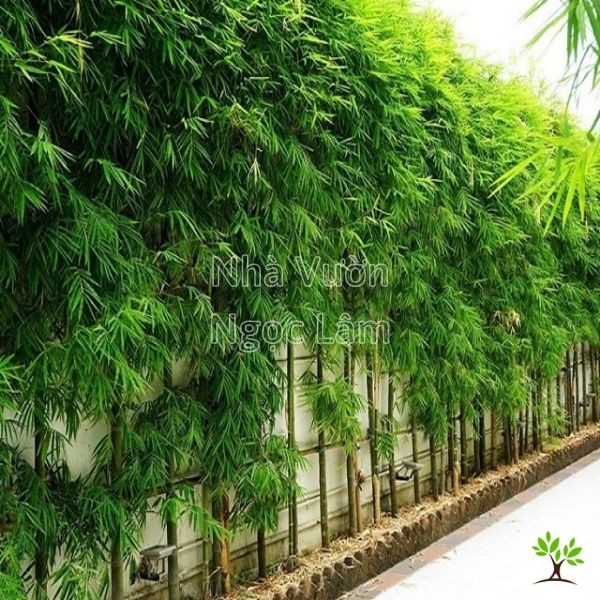 Lush green fronds of a Bamboo Palm plant suitable for balconies, symbolizing peace
Lush green fronds of a Bamboo Palm plant suitable for balconies, symbolizing peace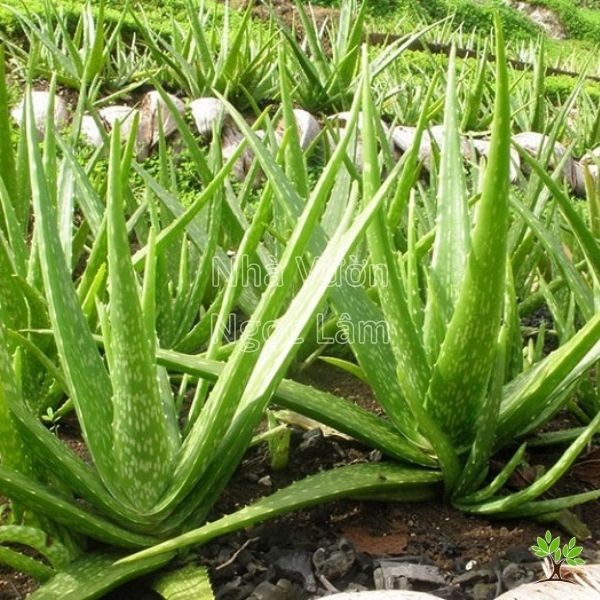 Spiky, fleshy leaves of an Aloe Vera plant in a pot, highlighting its drought tolerance and medicinal uses
Spiky, fleshy leaves of an Aloe Vera plant in a pot, highlighting its drought tolerance and medicinal uses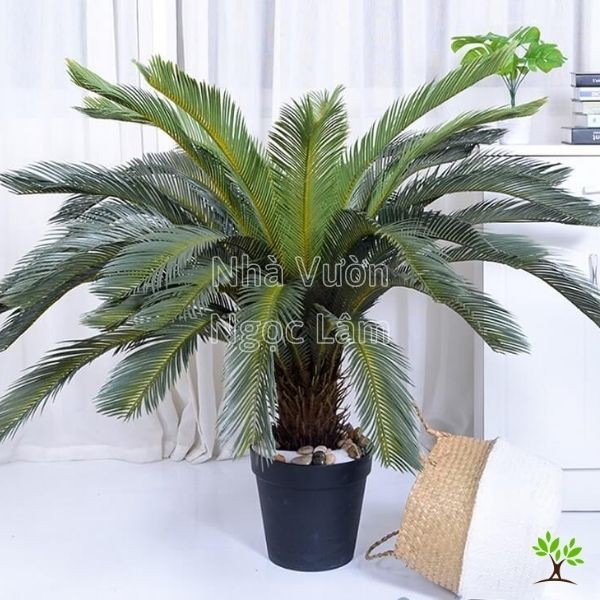 A young Japanese Sago Palm with spreading green fronds, a sun-loving plant for balcony shade
A young Japanese Sago Palm with spreading green fronds, a sun-loving plant for balcony shade Variety of small cacti growing in pots, hardy sun-tolerant plants for apartment balconies
Variety of small cacti growing in pots, hardy sun-tolerant plants for apartment balconies Colorful Petunia flowers in various shades overflowing from hanging baskets on a balcony
Colorful Petunia flowers in various shades overflowing from hanging baskets on a balcony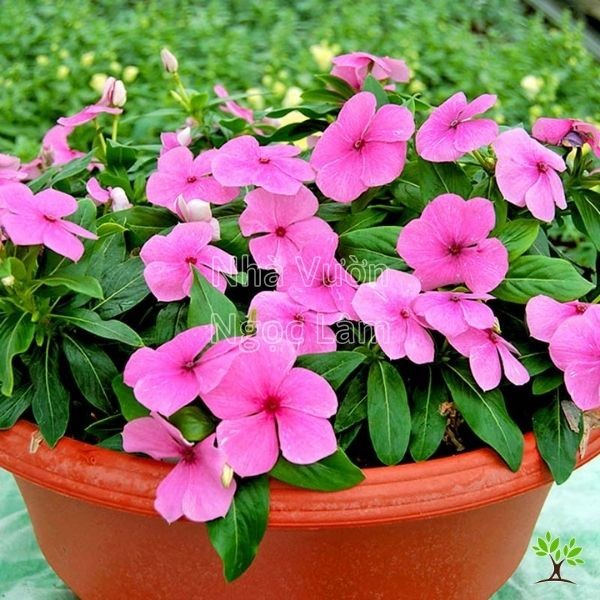 Bright pink and white Vinca flowers blooming profusely in a pot, a drought-tolerant balcony plant
Bright pink and white Vinca flowers blooming profusely in a pot, a drought-tolerant balcony plant Close-up of pink trumpet-shaped flowers of the Pink Trumpet Vine trailing on a support
Close-up of pink trumpet-shaped flowers of the Pink Trumpet Vine trailing on a support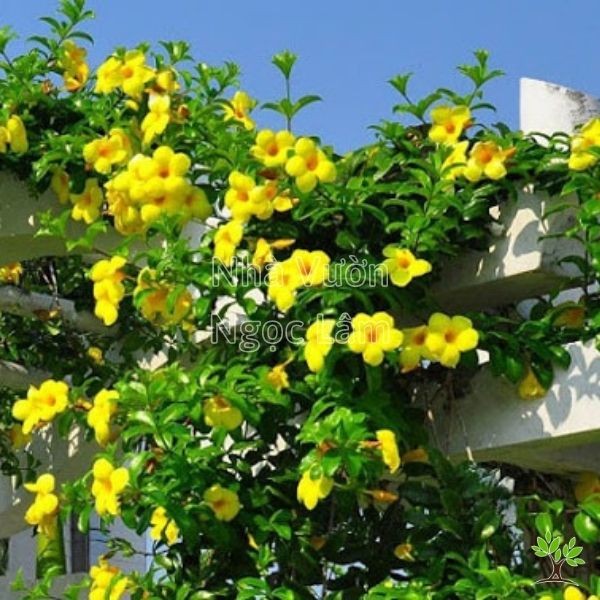 Bright yellow bell-shaped flowers of the Yellow Bell Vine climber
Bright yellow bell-shaped flowers of the Yellow Bell Vine climber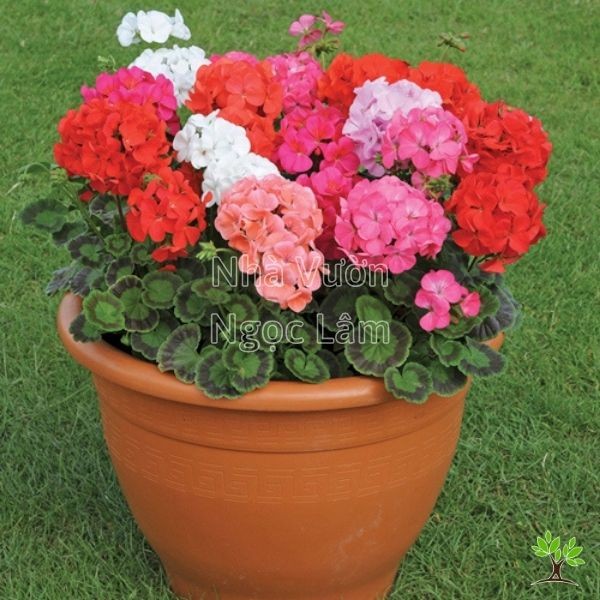 Cluster of vibrant red Geranium flowers blooming in a pot, suitable for sunny balconies
Cluster of vibrant red Geranium flowers blooming in a pot, suitable for sunny balconies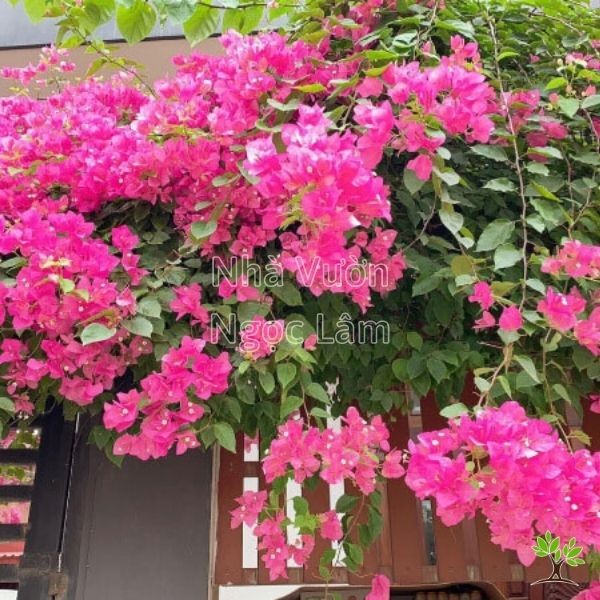 Brilliant magenta Bougainvillea flowers creating a wall of color on a sunny balcony
Brilliant magenta Bougainvillea flowers creating a wall of color on a sunny balcony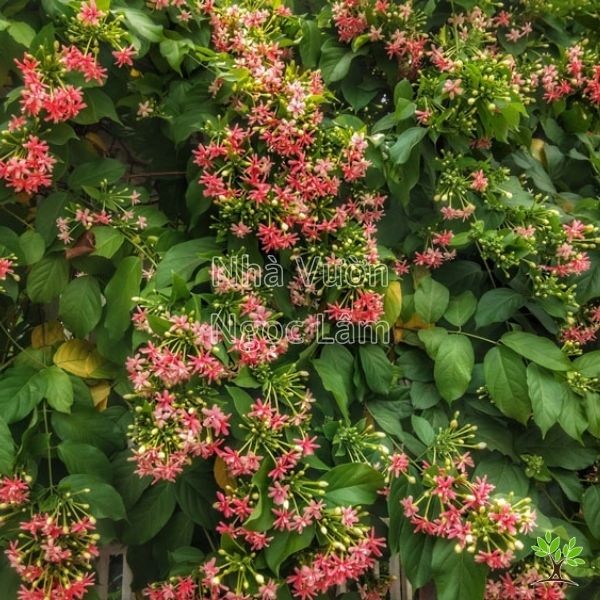 Clusters of red, pink, and white Rangoon Creeper flowers on a vine, suitable for sunny balconies
Clusters of red, pink, and white Rangoon Creeper flowers on a vine, suitable for sunny balconies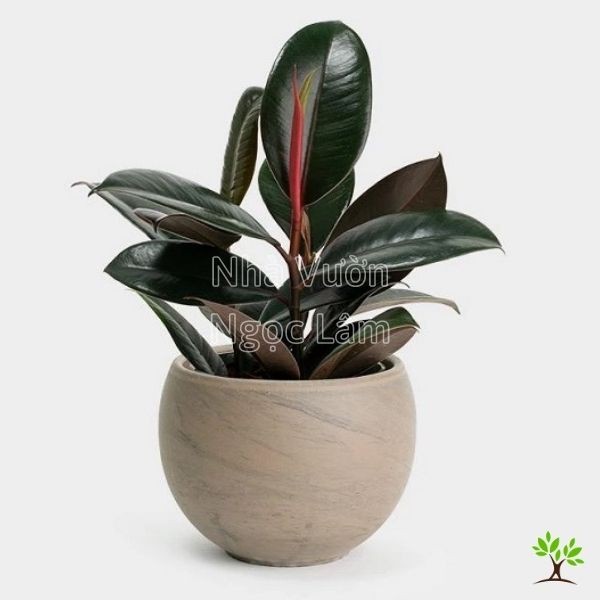 Glossy, dark red leaves of a Red Leaf Fig plant, a sun-tolerant and easy-care balcony plant
Glossy, dark red leaves of a Red Leaf Fig plant, a sun-tolerant and easy-care balcony plant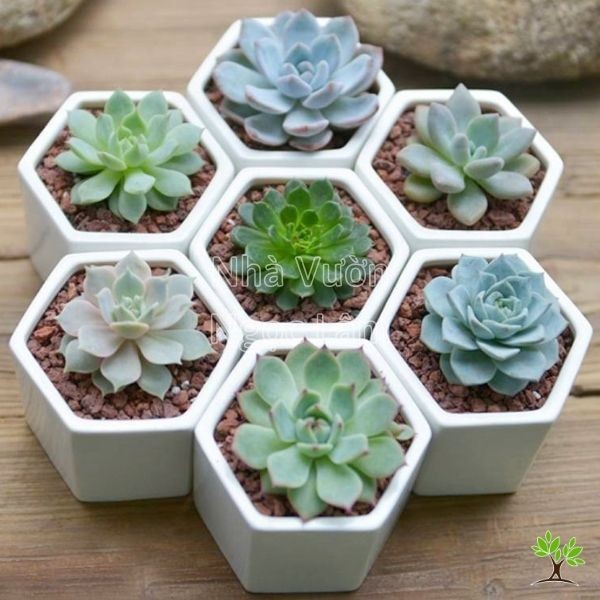 Various types of small succulents with fleshy leaves arranged in a pot, drought-tolerant balcony plants
Various types of small succulents with fleshy leaves arranged in a pot, drought-tolerant balcony plants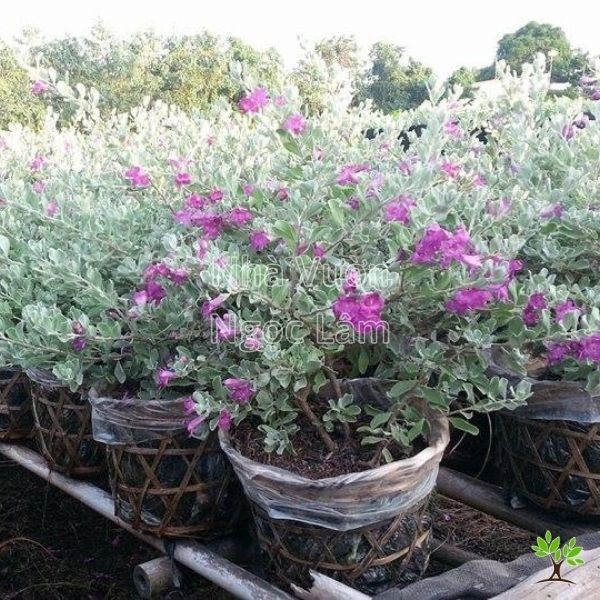 Close-up of the distinctive variegated silvery-green leaves with pink edges of Lavender Scallops (Kalanchoe fedtschenkoi)
Close-up of the distinctive variegated silvery-green leaves with pink edges of Lavender Scallops (Kalanchoe fedtschenkoi)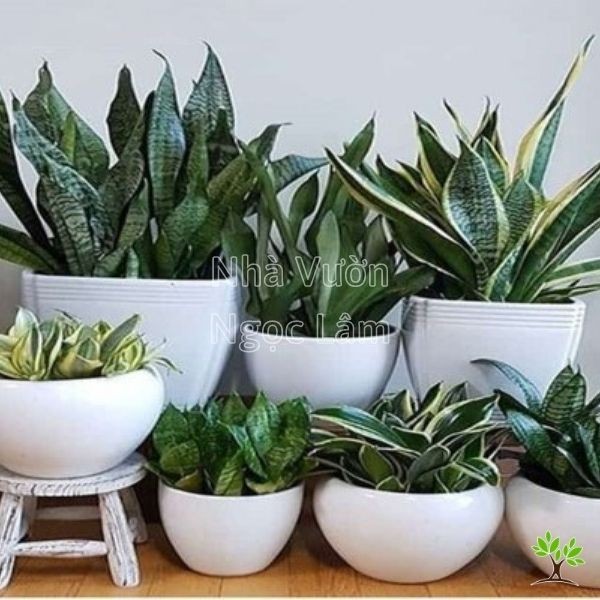 Tall, upright, dark green leaves of a Snake Plant (Sansevieria) in a pot, known for air purification
Tall, upright, dark green leaves of a Snake Plant (Sansevieria) in a pot, known for air purification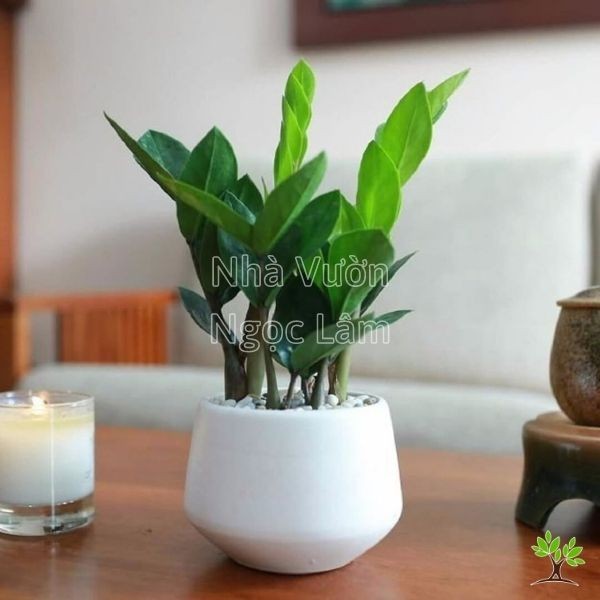 Glossy, dark green leaves of a ZZ Plant (Zamioculcas zamiifolia), an easy-care indoor or balcony plant
Glossy, dark green leaves of a ZZ Plant (Zamioculcas zamiifolia), an easy-care indoor or balcony plant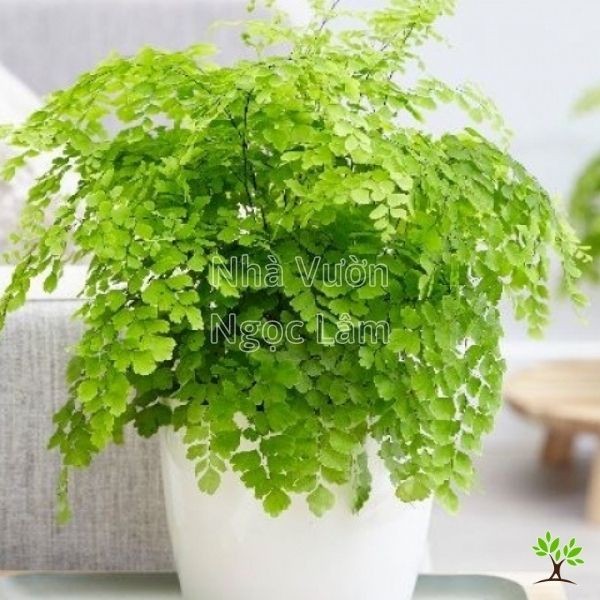 Delicate, lacy fronds of a Maidenhair Fern in a pot, an air-purifying plant
Delicate, lacy fronds of a Maidenhair Fern in a pot, an air-purifying plant Lush green fronds of a potted Fern, an effective air filtering plant for balconies
Lush green fronds of a potted Fern, an effective air filtering plant for balconies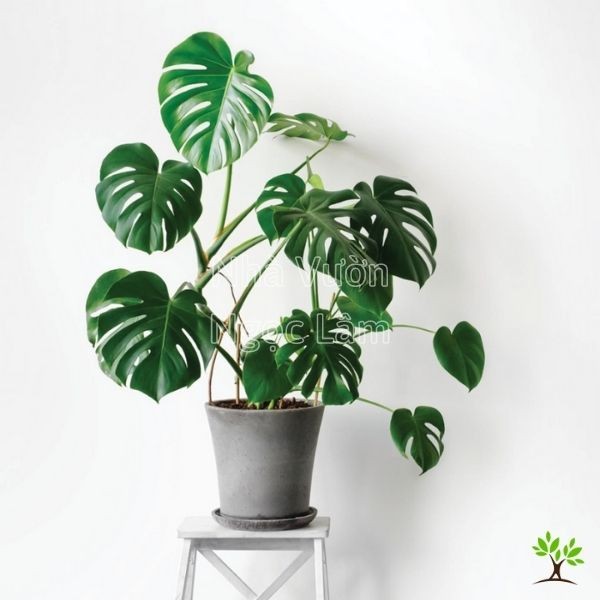 Large, distinctive split leaves of a Split-Leaf Philodendron (Monstera), an air-purifying plant
Large, distinctive split leaves of a Split-Leaf Philodendron (Monstera), an air-purifying plant Upright fan-shaped fronds of a Lady Palm (Rhapis excelsa), an air-purifying plant and sunshade
Upright fan-shaped fronds of a Lady Palm (Rhapis excelsa), an air-purifying plant and sunshade Heart-shaped red spathe and dark green leaves of an Anthurium (Flamingo Flower), an air-purifying plant
Heart-shaped red spathe and dark green leaves of an Anthurium (Flamingo Flower), an air-purifying plant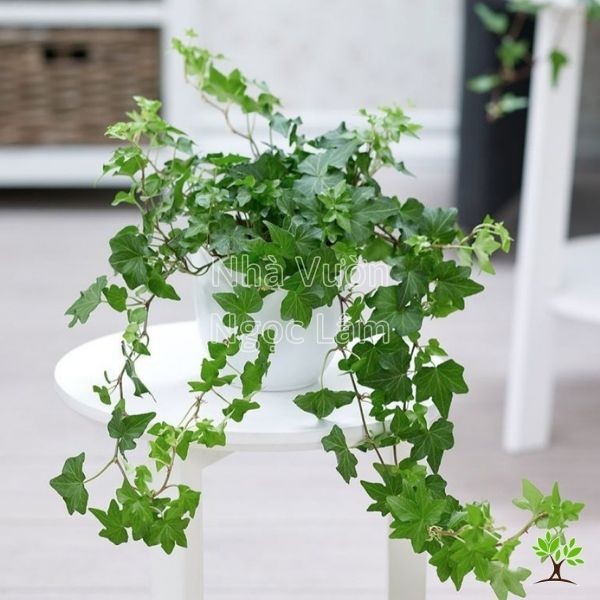 Trailing stems with classic lobed leaves of English Ivy, suitable for hanging or cascading on a balcony
Trailing stems with classic lobed leaves of English Ivy, suitable for hanging or cascading on a balcony Fine green leaves and stems of a Trailing Daisy plant cascading from a pot on a balcony
Fine green leaves and stems of a Trailing Daisy plant cascading from a pot on a balcony